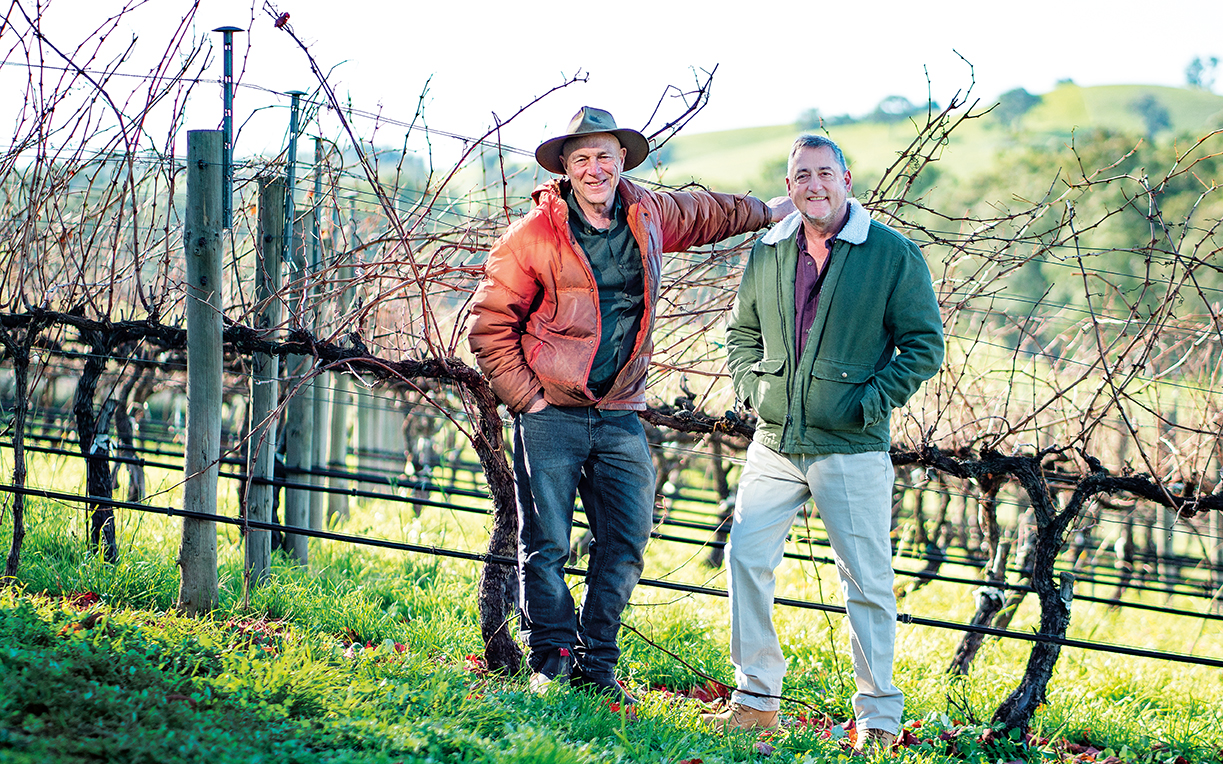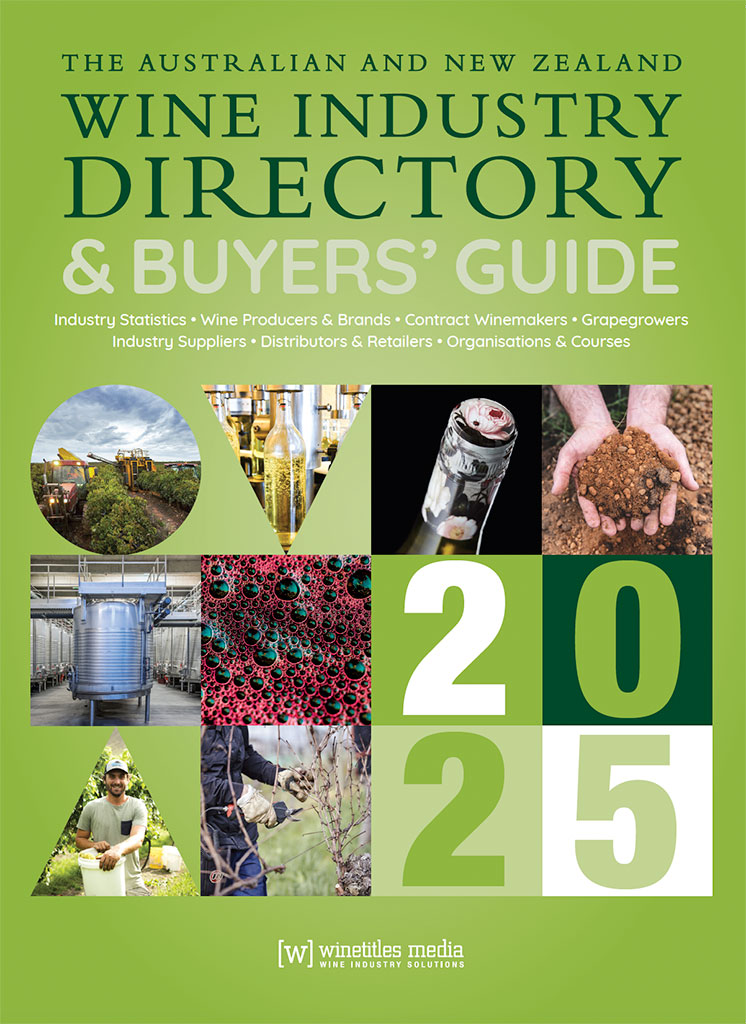Larry Jacobs (left) and Marc Dobson, co-owners of Hahndorf Hill, alongside their Blaufrankisch vines.
Beautiful Blaufränkisch
By Larry Jacobs, Co-owner, Hahndorf Hill, Adelaide Hills, South Australia
THE BACKGROUND
The first time I bumped into Blaufränkisch (aka Lemberger) was in 2002 when my partner and I purchased Hahndorf Hill in the Adelaide Hills from a German migrant who had developed and planted the vineyard in 1993.
Included in the selection of varieties that he had established was this mysterious red variety called Lemberger. He explained that the variety was popular in the sunny Württemberg wine region of Germany from which he hailed.
We initially didn’t give this obscure variety much consideration as there was much to do in order to get the vineyard, the cellar door and our new wine brand established. And so, initially, for the first three years, this exotic variety was simply automatically included in the blend used to make our lovely, dry rosé.
However, when we started developing an interest in so-called alternative varieties in 2006 — and more especially in the Austrian white variety called Grüner Veltliner — we suddenly realised that this dark horse known to us as Lemberger was also, in fact, the same variety known as Blaufränkisch, whose spiritual home is also in Austria, where it is celebrated as that country’s prestige red grape.
This discovery ignited sudden curiosity and intrigue about our newfound Austrian friend and so, in 2008, we produced our very first — and Australia’s first — Blaufränkisch wine.
The name Blaufränkisch is a composite of two words: blau and frankisch. ‘Blau’ means blue in German, referring to the attractive blue-coloured grapes, and the word ‘frankisch’ has several connotations, one being that it relates to the noble wine these grapes made which was highly favoured by the Frankish kings. We promptly settled on the name ‘Blueblood’ for our new label of Blaufränkisch.
Since then, this hauntingly beautiful variety has evolved to become a special offering in our wine portfolio. In fact, our family of Austrian varieties has expanded to not only include extensive plantings of the white variety Grüner Veltliner, but also plantings of two further red Austrian varieties, namely Zweigelt and St Laurent.
Interestingly, our three Austrian red varieties are indeed family in a true, genetic sense. Zweigelt is a cross of its parents, Blaufränkisch and St Laurent. Recently, we learned that Vienna’s viticultural school, Klosterneuburg, has proven via DNA analysis that St Laurent is the genetic daughter of Pinot Noir.
For many years, Hahndorf Hill was the sole producer of Blaufränkisch in Australia, but there are now other plantings in other wine regions, including the Yarra Valley, Tasmania and elsewhere in the Adelaide Hills.
THE VINES
Our Blaufränkisch vines are now nearly 30 years old and, as far as we are aware, they are own-rooted. They are planted 1.5m apart in 2.5m rows. The block has a south-western slope and the vines are planted north to south. They are spur-pruned with 10 spurs per cordon at two buds per spur. I am unaware of the clone that was planted, but the material was apparently sourced from within Australia.
The soils in this block comprise a 30cm topsoil layer of sandy loam heavily embellished with ironstone deposits, and a deep subsoil of red clay. This perfectly matches the soils in Austria’s southern Burgenland wine region, which has iron-rich soils of loam and clay. It is here in southern Burgenland that perhaps the most elegant styles of Blaufränkisch are produced.
Our Blaufränkisch block is drip irrigated. True to Germanic form, the vines are tidy and straight growing, and are therefore perfectly suited to our VSP trellis system.
Blaufränkisch buds and flowers about the same time as Chardonnay, but is reasonably late to ripen, being harvested regularly about 10 days before our Shiraz. Our Blaufränkisch is, therefore, generally harvested mid to late April.
In my experience, it does not seem to be particularly susceptible to powdery or downy mildew, nor to rot. However, in years of heavy pressure such as 2011, we did experience some bunch rot, as was the case with all other varieties.
It is a fairly generous yielder and generally offers one sizable bunch of between 140-160 grams plus a second slightly smaller bunch per cane. Occasionally I need to do some green harvesting to reduce potential yields.
As the fruit ripens, it develops very attractive blackberry and cherry favours. It has abundant fine tannin — which is never coarse nor heavy. The colour intensity will vary from year to year, but it is distinctly a medium-bodied red. However, this does not prevent this variety from producing wine of intensity, depth and complexity.
THE WINE
Our grapes are hand-harvested and we keep the fermentation process as direct as possible to allow for the natural expression of the fruit. The must is inoculated with yeast and then fermented in a stainless-steel fermenter. In some years we include a small percentage of whole bunches in the ferment. The wine is then aged in French barriques for approximately 12 months.
There was a trend in Austria in the past decade for some producers to endeavour to extract a more full-bodied style of Blaufränkisch and, as a consequence, considerable new oak was applied to these wines, with up to 100% new casks being used in some cases.
However, after 12 years’ experience with this variety in the winery, I now believe that it should rather be allowed to express its elegance rather than its muscle, so in recent years we have applied an oak regimen involving less than 20% new, tight-grain wood barriques.
I have also noticed over the years that, once bottled, it takes approximately three years of bottle-ageing for the fruit to develop and to start expressing itself fully. You will then be rewarded with an extremely appealing wine with an emphasis on black-brambly fruits, blueberries and blue-black cherries, coupled with some gentle spice and a signature juicy acidity.
Blaufränkisch is the top-selling red at our cellar door, appealing to customers looking for something different and delicious, but also to those whose tastes in wine have shifted away from heavier reds towards fresher, slimmer wines offering more versatility at
the table.
Blaufränkisch is perfectly matched to duck, venison, lamb and even salmon — but it is extraordinarily compatible with all spicy cuisines, both for the carnivore and the vegetarian. Truly a wine for all seasons and
all reasons.
Blaufränkisch
By Peter Dry, Emeritus Fellow, The Australian Wine Research Institute
Background
Blaufränkisch (BLAUW-frank-ish) is grown throughout central Europe but it is best known in Austria where it is the second-most important red wine variety after Zweigelt (a hybrid of Blaufränkisch and St. Laurent). In Hungary, where it has the largest area of any variety, it is known as Kékfrankos; and is the main variety used for the famous Egri Bikaver (‘Bull’s Blood’) wine of the Eger region in the east. There are more than 80 synonyms in use, including Lemberger or Blauer Lemberger in Germany (Württemberg), Frankovka in the Czech Republic and Croatia, Franconia in Italy and Modra Frankinja in Slovenia. The global area (2016) was 17,180ha (up 22% from 2000) with the largest areas in Hungary (7260ha) and Austria (2808ha). Slovakia, Czech Republic, Serbia, Slovenia and Croatia also have significant areas. Its popularity has been increasing in recent times, both in Europe and internationally. For example, in the USA it has been planted in Virginia, Washington and New York states. At this stage, the planted area in Australia is small, with just two wine producers: one of which is in the Adelaide Hills (Hahndorf Hill, the first to use the variety), the other is in northern Tasmania.
Viticulture
Budburst is early and maturity is mid-season (in Australia). Vigour is high with semi-erect growth habit. Bunches are medium and loose with medium black berries. Yield is moderate. Spur pruning is successful in Australia. It has average susceptibility to Oidium and downy mildew but is reasonably tolerant of Botrytis. It is most likely to be suited to cool regions in Australia.
Wine
Blaufränkisch wines are well-structured with good colour, firm acidity, medium to full body and generous flavour. Descriptors include black cherry, raspberry, dark chocolate, fennel and spicy. Wines can have good ageing potential. It has been likened to a ‘full-bodied Pinot Noir’ or a ‘dense Beaujolais’


















